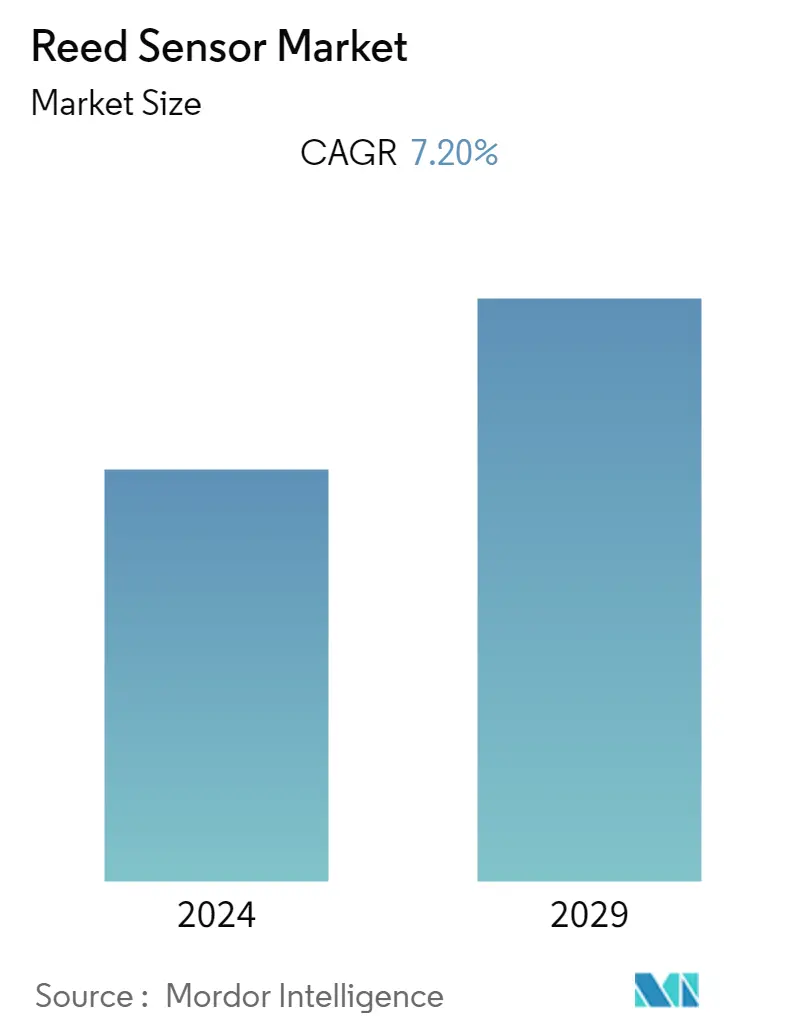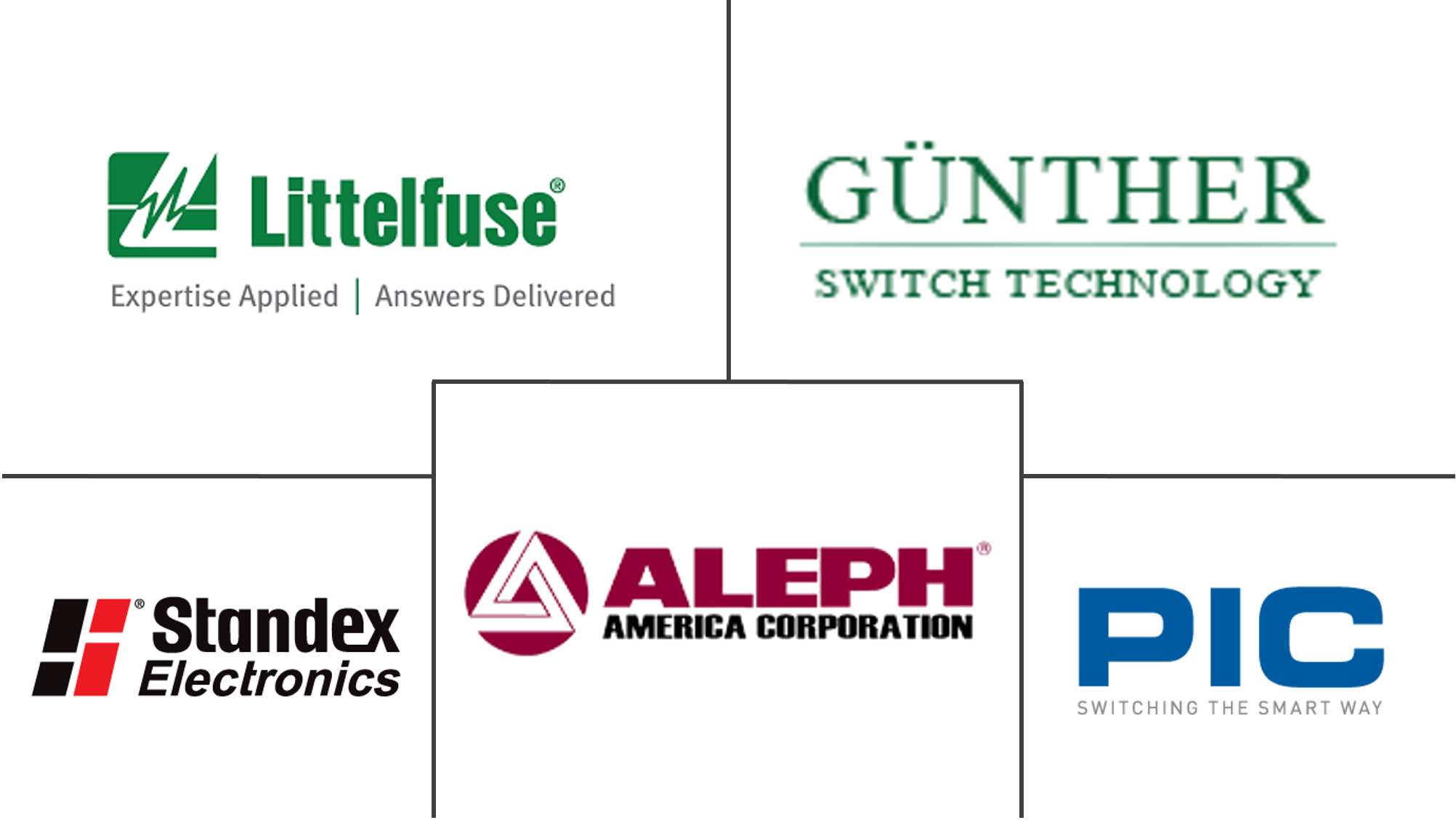Market Size of Reed Sensor Industry

| Study Period | 2019 - 2029 |
| Base Year For Estimation | 2023 |
| CAGR | 7.20 % |
| Fastest Growing Market | Asia Pacific |
| Largest Market | North America |
| Market Concentration | Medium |
Major Players
*Disclaimer: Major Players sorted in no particular order |
Reed Sensor Market Analysis
The reed sensor market is anticipated to grow at a CAGR of 7.2% from the year (2021 - 2026). Due to technological advancements in the sensor and switch technology, there is a trend towards high miniaturization and highly reliable reed switches are acting as a driver for the reed sensor in various end-user industries.
- Adoption in low power metering applications and capable of working in harsh environments drives the market, in products such as electricity meters, heat meters, etc. For instance, gas and water meters suitable with automatic meter reading systems need sensors that use very little power consumption. Water and gas usage is generally measured by a magnet attached to a rotating shaft where each revolution is converted into an electrical signal and accumulated by an embedded controller. Low power consumption is a critical design parameter in these systems by which reed sensors embedded with reed switch are in demand in these applications.
- The increase in industrial automation and the boom of Industrial 4.0 will lead to the adoption of reed sensor market. According to IFR, till 2022, there will be around 630,000 robots unit shipments globally. New technology and global standards ensure a safe workplace, boost productivity, and reduce environmental impact. Every hydraulic or pneumatic cylinder or actuator involves a reed sensor for end position sensing. Unlike inductive sensors or Hall-effect sensors, these sensors use no power and have good isolation. They have high operating speeds, work with a wide range of voltages of programmable logic controllers (PLCs) and micro-controllers, which enhances productivity.
- Reliability and durability challenges the reed switch which restraints the market for reed sensor. Reed switches have several inherent disadvantages, which includes susceptibility to breakage issues during installation, propensity to shock or vibration applications, lower durability, limited life due to the mechanical nature of the switch, as well as issues due to the contact bounce.
Reed Sensor Industry Segmentation
Reed sensors, due to their reliable and simple sensing with actuation capabilities and low cost and zero power requirement for operation, have been witnessing high adoption across industries such as automotive, consumer electronics, robotics, etc.
| By Application | |
| Automotive | |
| Consumer Electronics | |
| Industrial | |
| Safety & Security Systems | |
| Healthcare | |
| Other Applications |
| Geography | |||||||
| |||||||
| |||||||
| |||||||
|
Reed Sensor Market Size Summary
The reed sensor market is poised for significant growth, driven by advancements in sensor and switch technology that emphasize miniaturization and reliability. These sensors are increasingly adopted in low power metering applications, such as electricity and heat meters, where their ability to function in harsh environments and consume minimal power is crucial. The rise of industrial automation and the Industrial 4.0 movement further propel the demand for reed sensors, as they are integral to the operation of hydraulic and pneumatic systems, offering advantages like high operating speeds and good isolation without power consumption. However, challenges such as the inherent susceptibility of reed switches to breakage, shock, and vibration, along with limited durability and mechanical wear, pose constraints to market expansion.
In the automotive sector, the demand for reed sensors is bolstered by the increasing emphasis on safety features in vehicles, particularly in light commercial vehicles. These sensors play a vital role in passive safety systems, such as early brake sensing and passenger detection for airbag deployment, enhancing vehicle safety and reducing accident rates. Additionally, thermal reed sensors are employed to monitor engine temperatures, preventing fire hazards. The Asia-Pacific region, with its robust electronics and automotive industries, particularly in China and Taiwan, is a key growth area for reed sensors. The burgeoning smart home market in South Korea and advancements in robotics in India also contribute to market expansion. Despite moderate market competition, with established players like Littelfuse and Standex Electronics, the presence of local manufacturers intensifies rivalry, fostering innovation and development in reed sensor technology.
Reed Sensor Market Size - Table of Contents
-
1. MARKET DYNAMICS
-
1.1 Market Overview
-
1.2 Introduction to Market Drivers and Restraints
-
1.3 Market Drivers
-
1.3.1 Adoption in Low Power Metering Applications
-
1.3.2 Increase in Industrial Automation and Boom of Industrial 4.0
-
-
1.4 Market Restraints
-
1.4.1 Challenges in Reliability and Durability for Reed Switches
-
-
1.5 Value Chain Analysis
-
1.6 Industry Attractiveness - Porter's Five Force Analysis
-
1.6.1 Threat of New Entrants
-
1.6.2 Bargaining Power of Buyers/Consumers
-
1.6.3 Bargaining Power of Suppliers
-
1.6.4 Threat of Substitute Products
-
1.6.5 Intensity of Competitive Rivalry
-
-
-
2. MARKET SEGMENTATION
-
2.1 By Application
-
2.1.1 Automotive
-
2.1.2 Consumer Electronics
-
2.1.3 Industrial
-
2.1.4 Safety & Security Systems
-
2.1.5 Healthcare
-
2.1.6 Other Applications
-
-
2.2 Geography
-
2.2.1 North America
-
2.2.1.1 United States
-
2.2.1.2 Canada
-
-
2.2.2 Europe
-
2.2.2.1 Germany
-
2.2.2.2 United Kingdom
-
2.2.2.3 France
-
2.2.2.4 Italy
-
2.2.2.5 Rest of Europe
-
-
2.2.3 Asia-Pacific
-
2.2.3.1 China
-
2.2.3.2 Japan
-
2.2.3.3 India
-
2.2.3.4 South Korea
-
2.2.3.5 Rest of Asia-Pacific
-
-
2.2.4 Rest of the World
-
2.2.4.1 Latin America
-
2.2.4.2 Middle-East & Africa
-
-
-
Reed Sensor Market Size FAQs
What is the current Reed Sensor Market size?
The Reed Sensor Market is projected to register a CAGR of 7.20% during the forecast period (2024-2029)
Who are the key players in Reed Sensor Market?
Littelfuse, Inc, Standex Electronics, Inc. (Standex International Corporation), PIC GmbH, Aleph America Corporation and STG Germany GmbH are the major companies operating in the Reed Sensor Market.

